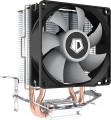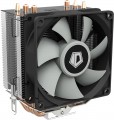Max. TDP
The maximum TDP provided by the cooling system. Note that this parameter is indicated only for solutions equipped with heatsinks (see "Type"); for separately made fans, the efficiency is determined by other parameters, primarily by the air flow values (see above).
TDP can be described as the amount of heat that a cooling system is able to remove from a serviced component. Accordingly, for the normal operation of the entire system, it is necessary that the TDP of the cooling system is not lower than the heat dissipation of this component (heat dissipation data is usually indicated in the detailed characteristics of the components). And it is best to select coolers with a power margin of at least 20 – 25% — this will give an additional guarantee in case of forced operation modes and emergency situations (including clogging of the case and reduced air exchange efficiency).
As for specific numbers, the most modest modern cooling systems provide TDP
up to 100 W, the most advanced —
up to 250 W and even
higher.
Fan size
The diameter of the fan(s) used in the cooling system.
In general, larger fans are considered more advanced than smaller ones: they allow you to create a powerful air flow at a relatively low speed and low noise level. On the other hand, a large diameter means large dimensions, weight and price. As for specific figures,
40 mm and
60 mm models are considered miniature,
80 mm and
92 mm are medium,
120 mm and
135 /
140 mm are large, and even
200 mm fans are found in the most powerful
case systems.
Max. RPM
The highest speed at which the cooling system fan is capable of operating; for models without a speed controller (see below), this item indicates the nominal rotation speed. In the "slowest" modern fans, the maximum speed
does not exceed 1000 rpm, in the "fastest" it can be up
to 2500 rpm and even
more.
Note that this parameter is closely related to the fan diameter (see above): the smaller the diameter, the higher the speed must be to achieve the desired airflow values. In this case, the rotation speed directly affects the level of noise and vibration. Therefore, it is believed that the required volume of air is best provided by large and relatively "slow" fans; and it makes sense to use "fast" small models where compactness is crucial. If we compare the speed of models of the same size, then higher speeds have a positive effect on performance, but increase not only the noise level, but also the price and power consumption.
Speed controller
—
Auto (PWM). A type of automatic regulator used in processor cooling systems. The principle of this adjustment is that the automation monitors the current load on the CPU and adjusts the fan operation mode to it. Thus, the cooling system works "in advance": it actually prevents the temperature rise, and does not eliminate it (unlike the thermostat described below). The disadvantages of such automation are the high cost and additional compatibility requirements: the PWM function must be supported by the motherboard, and the fan must be powered through a 4-pin connector (see "Power").
— Manual. Manual regulator that allows you to set the rotation speed at the request of the user. Its main advantages are both the possibility of arbitrary adjustment and reliability: automation does not always respond optimally, and in performant systems it is sometimes better for the user to take control into his own hands. On the other hand, manual control is more expensive and also more difficult to use — it requires the user to pay more attention to the state of the system, and if not attentive, the likelihood of overheating increases significantly.
— Manual / auto. A combination of the two systems described above: the main control is carried out by PWM, and the manual regulator serves to limit the maximum rotational speed. A fairly convenient and advanced option that expands the possibilities of auto-adjustment and at the same time doe
...s not require constant temperature control, as with a purely manual setting. However such functionality is expensive.
— Adapter (resistor). In this case, the speed is adjusted by reducing the voltage supplied to the fan. To do this, it is connected to the power supply through a resistor adapter. This is a kind of alternative to manual adjustment: adapters are inexpensive. On the other hand, they are much less convenient: the only way to change the rotation speed with such an adjustment is to actually change the adapter, and for this you have to turn off the system and climb into the case.
— Thermostat. Automatic speed control according to data from a sensor that measures the temperature of the cooled component: when the temperature rises, the intensity of work also increases, and vice versa. Such systems are simpler than the PWMs described above, moreover, they can be used for almost any system component, not only for CPU. On the other hand, they have more inertia and reaction time: if the PWM prevents heating in advance, then the thermostat is triggered by an increase in temperature that has already happened.Max. air flow
The maximum airflow that a cooling fan can create; measured in CFM — cubic feet per minute.
The higher the CFM number, the more efficient the fan. On the other hand, high performance requires either a large diameter (which affects the size and cost) or high speed (which increases the noise and vibration levels). Therefore, when choosing, it makes sense not to chase the maximum air flow, but to use special formulas that allow you to calculate the required number of CFM depending on the type and power of the cooled component and other parameters. Such formulas can be found in special sources. As for specific numbers, in the most modest systems, the performance
does not exceed 30 CFM, and in the most powerful systems it can be up to 80 CFM and even
more.
It is also worth considering that the actual value of the air flow at the highest speed is usually lower than the claimed maximum; see Static Pressure for details.
Static pressure
The maximum static air pressure generated by the fan during operation.
This parameter is measured as follows: if the fan is installed on a blind pipe, from which there is no air outlet, and turned on for blowing, then the pressure reached in the pipe will correspond to the static one. In fact, this parameter determines the overall efficiency of the fan: the higher the static pressure (ceteris paribus), the easier it is for the fan to “push” the required amount of air through a space with high resistance, for example, through narrow slots of a radiator or through a case full of components.
Also, this parameter is used for some specific calculations, however, these calculations are quite complex and, usually, are not necessary for an ordinary user — they are associated with nuances that are relevant mainly for computer enthusiasts. You can read more about this in special sources.
Starting voltage
The starting voltage of the fan installed in the cooling system. In fact, this is the smallest value necessary for stable operation of the fan — if the voltage is too low, it simply “will not start”. Note that this parameter is relevant mainly for rather specific tasks — for example, installing a fan in a power supply unit with a direct connection to the PSU, or choosing an external controller to control the rotation speed. When connected through standard power connectors, you can not pay much attention to the starting voltage.
Heat pipes
Number of heat pipes in the cooling system
The heat pipe is a hermetically sealed structure containing a low-boiling liquid. When one end of the tube is heated, this liquid evaporates and condenses at the other end, thus removing heat from the heating source and transferring it to the cooler. Nowadays, such devices are widely used mainly in processor cooling systems (see "Intended use") — they connect the substrate that is in direct contact with the CPU and the heatsink of the active cooler. Manufacturers select the number of tubes based on the overall performance of the cooler (see "Maximum TDP"); however, models with similar TDPs can still differ markedly in this parameter. In such cases, it is worth considering the following: increasing the number of heat pipes increases the efficiency of heat transfer, but also increases the dimensions, weight and cost of the entire structure.
As for the number, the simplest models provide
1 – 2 heat pipes, and in the most advanced and powerful processor systems, this number can be
7 or more.
Socket

